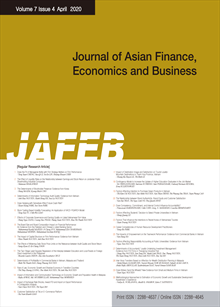간행물
The Journal of Asian Finance, Economics and Business KCI 등재 SCOPUS

- 발행기관 한국유통과학회
- 자료유형 학술지
- 간기 계간
- ISSN 2288-4637 (Print)2288-4645 (Online)
- 수록기간 2014 ~ 2020
- 주제분류 사회과학 > 경영학 사회과학 분류의 다른 간행물
- 십진분류KDC 325DDC 330
권호리스트/논문검색
제1권 제3호 (2014년 8월) 4건
1.
2014.08
서비스 종료(열람 제한)
This study aims to examine the dynamics of price changes and trading volume of Kuala Lumpur Options and Financial Futures Exchange (KLOFFE) from 2000 to 2008. With augmented analysis, our results support two hypotheses. First, under information spillover, our findings support noise traders’ hypothesis as the time span for variance of past trading volume to cause variance of current return is found to be asymmetric under bull and bear markets. Second, looking at the dynamic relation between volume and volatility of price changes, our findings support Liquidity-Driven Trade hypothesis as past trading volume and subsequent volatility of return exhibit positive correlation. In terms of investors’ behavior in response to the news, we find that investors are more risk taking in bull market and more risk reverse in bear market. Our study suggests that investors should adjust their strategy in the futures market in a dynamic manner as the time span of new information arrival is not consistent. Also, uninformed investors with information asymmetry should expect noninformational trading from informed investors to establish their desired positions for better liquid position.
2.
2014.08
서비스 종료(열람 제한)
The paper deals with the impact of the product distribution and information technology sectors on energy resource use, carbon emissions and economic growth by examining the long-run equilibrium relationships and Granger causal relationships among these variables in South Korea. The quarterly time series data from the first quarter of 1970 to the third quarter of 2010 (163 observations) are collected and retrieved from the Bank of Korea database. The paper examines the long-run equilibrium relationships using cointegration techniques and Granger causality using vector error correction models. Test results indicate a long-run equilibrium relationship exists among these variables. In testing directional causality, both the product distribution and the information technology sectors show direct effects on economic growth but only marginal effects on carbon emissions.
3.
2014.08
서비스 종료(열람 제한)
This paper attempts to measure the impact of non-financial factors including analyst practices and broker resources on performance of sell side research. Results reveal that these non-financial factors have a measurable impact on performance of target price forecasts. Number of pages written by an analyst (surrogate for analyst practice) is significantly and directly linked with target price accuracy indicating a more elaborate analyst produces better target price forecasts. Analyst compensation (surrogate for broker resource) is significantly and inversely linked with target price accuracy. Out performance by analysts working with lower paying firms is possibly associated with motivation to migrate to higher paying broking firms. The study finds that employing more number of analysts per research report has no significant impact on target price accuracy –negative coefficient indicates that team work may not result in better target price forecasts. Though insignificant, long term forecast horizon negatively affects target price accuracy while stock volatility improves target price accuracy.
4.
2014.08
서비스 종료(열람 제한)
Most to Least Preferred Parameters Affecting the Quality of Education: Faculty Perspectives in India
The objective of the study is to find out the faculty members’perspective of most and least preferred parameters affecting the quality of education in an affiliated undergraduate engineering institution in Haryana, India. It is a descriptive research. The data has been collected with the help of Questionnaire Based Survey. The sample size for the study is 110. The respondents are the faculty members teaching B. Tech who were selected randomly from the above said geographical area. For data analysis and conclusion of the results of the survey, statistical tool like factor analysis was performed in SPSS. The most preferred aspects of the institution by the faculty members are: a secured Wi-Fi facility is well channelized to provide easy access, library is well equipped, faculty can visit the library with ease whenever they find time, toilets for the faculty are hygienic and in adequate number, parking facility for the faculty vehicle is spacious, adequate Industry Institute Interaction for the faculty development etc. The least preferred aspects of the institution by the faculty members are: faculty / staff rooms are spacious, well furnished and adequate in number, and working relationships between the Head of Departments and their faculty members are synchronized

